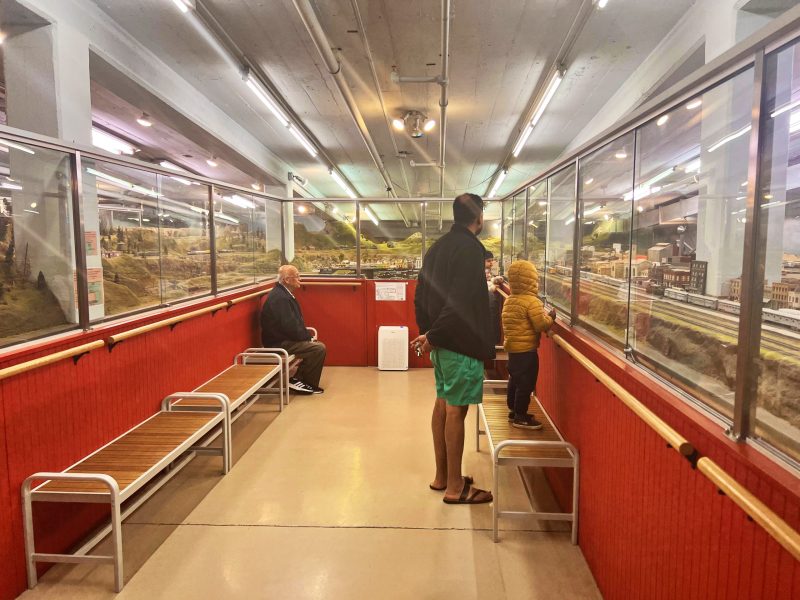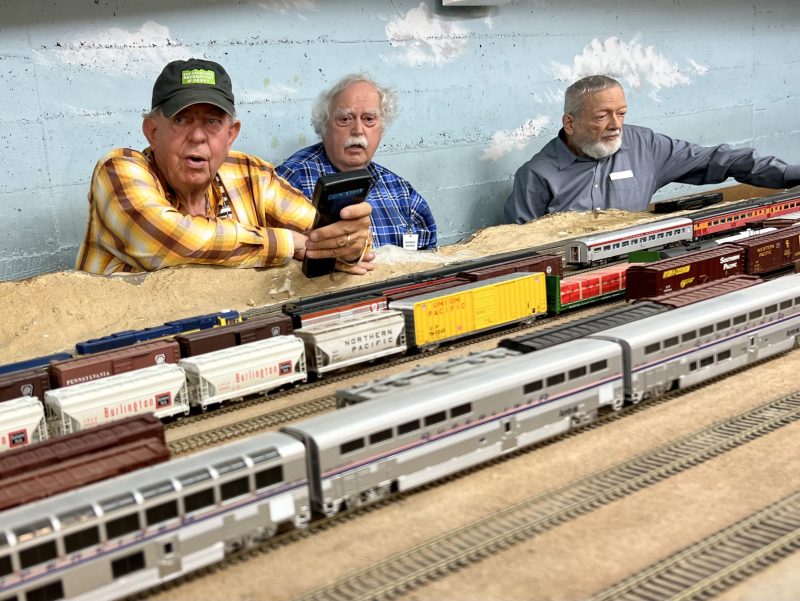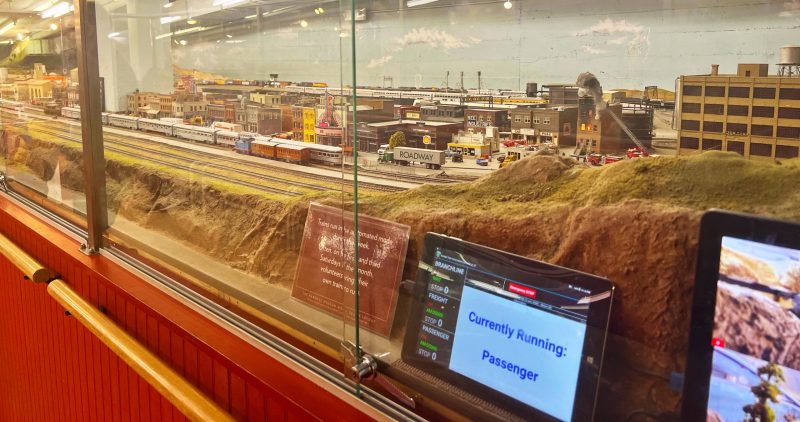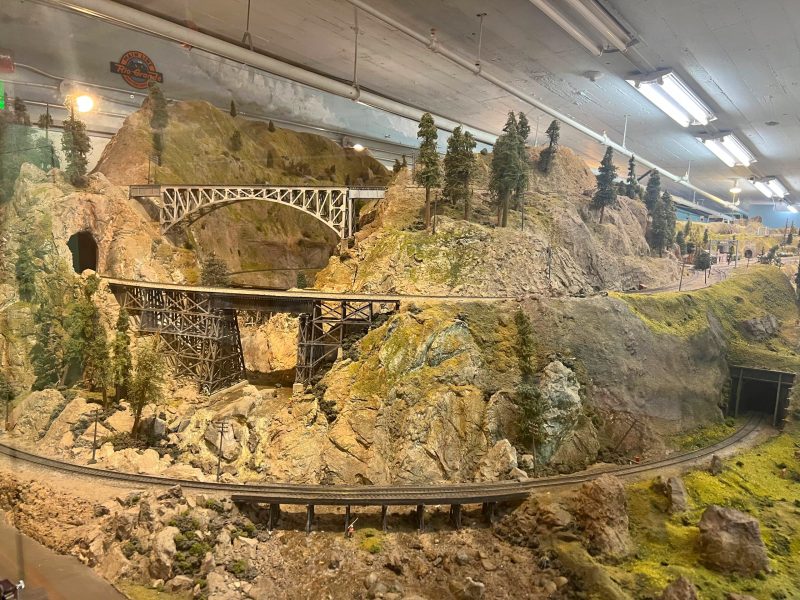Gigantic miniature train layout resurrected at Randall Museum by retired seniors, a student and an engineer who ‘thought they could’
If you like trains, why not take a ride on the Sierra Nevada and Pacific Railroad, or as railroad buffs call it, the SN&P? It will take you over bridges, through mountain tunnels and snow sheds as you head to the foothills of the Sierra, passing through Napa, Richmond, Fairfield, Lodi, Stockton, Sonora, Summit, and Bridgeport.

How do you buy a ticket? Well, you can’t. The SN&P is a fictional miniature train layout built by model railroad enthusiasts and housed in the basement of San Francisco’s Randall Museum.
But don’t confuse it with the electric trains you might have played with when you were a kid. The 52-year-old layout encompasses more than 2,100 square feet, some 800 feet of track, and more than 200 scale model train cars and locomotives. As many as six trains run at a time, trundling through a landscape of carefully crafted small towns and painted mountains made of chicken wire and concrete. There’s even a representation of a burning building surrounded by fire trucks with firefighters battling the blaze.
Fascination hit early
The SN&P was created by the now-defunct Golden Gate Model Railroad Club, but it’s now in the hands of a cadre of five volunteers — including three retired seniors, a high school student, and a software engineer.


None of the volunteers have real-world experience with railroads, but all came to love trains as young people. “I’m a fanatic railroad person,” said Jim Evans, the group’s model railroad coordinator. Evans, a stocky man wearing railroad track suspenders, has been volunteering at the museum since 2010. His dad, a Marine officer, was a strict disciplinarian, so “playing with trains is how I stayed out of trouble,” he said.
Evans, 73, spent 43 years working for BART as its parking administrator. Like the other volunteers, he has a specialty – train horns and locomotives, which can cost as much as $700, an expense he bears on his own. He likes railroad air horns so much he’s built a web page devoted to the subject. As he chatted, a refrigerator train modeled after one that ran in the 1940s chugged past, artificial steam wafting from its stack.
The trains he puts together are all modeled on trains that ran in the past. “I try and duplicate what ran in the real world,” he said. Indeed, the entire SN&P layout is loosely based on commercial railroad lines that served California decades ago.
Allan Phillips 77, came to love trains as a youngster, riding with his mother from the family home in Shreveport, Louisiana, to relatives in Texas and Louisiana. He maintained that habit as a student at Louisiana State University, taking trains from home to college between semester breaks. Now a retired computer programmer, Phillips lived near a Woolworths in Manhattan that sold trains and started collecting.
Entering the digital era
By the time he moved to San Francisco, his collection grew too large to fit comfortably in his Ingleside apartment. He heard about the Randall setup last year and decided to donate some of his trains. The volunteers were so impressed with him, they asked him to join. He once worked near New York’s Pennsylvania Station and became a fan of the long-gone Pennsylvania Railroad. These days he likes to model its equipment for the museum’s layout.
The layout was created in the early 1950s by enthusiasts who formed the Golden Gate Model Railroad Club. It was housed in a storefront in the Ingleside District. The building was sold in 1961 and the Randall Museum offered space in its basement.


For years, trains could only run on Saturdays when the volunteers were there to control them manually, using transformers similar to those you’d see on a home train set. But after the museum closed for a two-year, $9 million renovation in 2015, Raphael Moll, a software engineer, installed digital controls. Those controls automated the layout, allowing the trains to run unattended, so visitors can now see them in action whenever the museum is open. At about that time, the volunteers donated the layout to the museum, ending a sometimes contentious period and ensuring that it will have a stable home in the future.
Upgrading the layout was a challenge. Although its design and construction were “rock solid,” it was decades old and lacked detailed documentation, said Moll, a volunteer since 2015. And while the museum was closed, he and he and his colleagues had only limited access to the basement. So Moll built a prototype in his own home and wrote the software code needed to automate the system. The work was completed in time for the trains to run when the museum reopened in early 2018.
For kids and adults alike
Allen Brignetti, 73, with a shock of white hair and a heavy mustache, spent nearly four decades working for Safeway as a butcher and meat department manager, a job that had nothing to do with trains – real or modeled. But as a boy, he traveled by train from his native San Francisco to Chicago with his mom. The long ride was so bumpy he couldn’t sleep, but it hooked him on railroading. He’d play with his brother’s trainset as a boy, and as an adult kept a layout under his bed. Now, he’s a volunteer helping to keep the train layout in good shape and enjoys frequent trips to Tahoe: By train, of course.

Generations of grade school kids have come to the Randall Museum on field trips, and the layout remains a popular attraction. On a recent Saturday, Cecile Puretz and her 4-year-old niece were watching the trains. “I’ve been coming here since I was a kid,” said Puretz. “These days everything is computerized; these trains are a slice of old Americana.” As she talked, her niece waved to a passing passenger train, hoping someone would wave back.
A few minutes later, the two played hide and seek inside a mockup of a caboose and sang a line from a favorite song by Peter, Paul and Mary: “Freight train, freight train goin’ so fast.”






jim clifford
great photos. hope I can get a chance to see it. Like Sheldon on The Big Bang, I love trains.